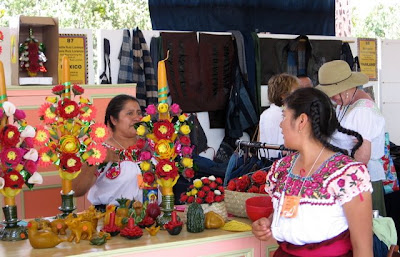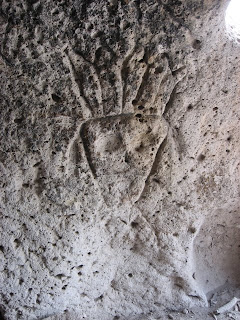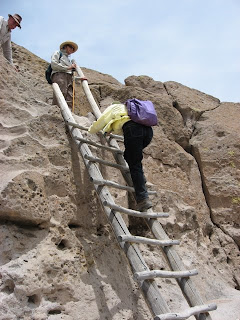
Last week I traveled to the Valles Caldera (which literally means "cooking pot valleys") with a Southwest Seminars group in conjunction with the Santa Fe Newcomers' Club.

Geologist
Dr. Kirt Kempter (who has studied plate tectonics and volcanism around the world) was our guide for the day.

About 1.25 million years ago, a volcanic eruption occurred in the Jemez Mountains. After the first phase, which spewed magma maybe 10-12 miles up into the stratosphere, crystals and ash (known as tephra) rained (or more descriptively, snowed) down on the area.

After a few hours, waves of so-called pyroclastic flows (very hot and very fast--600-700 degrees in temperature, and moving at 100-200 mph) spread across the region, filling valleys, and forming plateaus such as the Pajarito Plateau (which was the subject of a
recent post). The photo above shows a small part of the Plateau, which we passed on our way up to the Valles Caldera.
Finally, after the magma was depleted, the earth's crust around the vents began to collapse. The east side of what is now known as the Valles Caldera collapsed nearly a mile--the west side only about a quarter of a mile.

The area has had an interesting history. Pueblo Indians (from nine different pueblos along the Rio Grande) hunted, farmed, and collected tool-making rocks in the Caldera (such as the obsidian outcropping shown in the photo above which was used to make arrowheads) before the Spanish came. When the Spanish brought sheep, horses, and cattle, the lush summer grasslands provided ideal grazing.
In 1860, 12 years after the US took over the area, a land-grant settlement was reached by awarding a grant of 100,000 acres (almost the entire Valles Caldera) to the heirs of Cabeza de Vaca (see my
previous post on the Cabeza de Vacas). Four private owners held the land until 2000 when the US government purchased it and established the
Valles Caldera National Preserve.

Today, the Caldera is home to the second largest elkherd in the state (numbering about 3,000), and its beautiful meadows and slopes are also home to deer, golden eagles, mountain lions, bobcats, bears, 60 species of birds, and wild turkeys. Lottery-based fishing permits are available, and each fisherman gets about a mile of stream to him/herself for the day to fish for the native trout.
In the winter, it is a fabulous location for cross-country skiing, snowshoeing, and sleigh rides when the weather cooperates!
The Preserve also hosts a number of special events including mountain bike rides, overnight birding events, fly fishing clinics, elk hunts, and night sky adventures. The number of visitors to the Preserve is controlled--so you really get a chance to experience nature and not crowds.
Illustration Credits and ReferencesThanks to my friend Gloria Gordon for the wildlife photo.
This post was informed by
Valles Caldera: Map and Geologic History of the Southwest's Youngest Caldera, a High Desert Field Guide authored by Kirt Kempter and Dick Huelster, and by the website and brochures of the Valles Caldera National Preserve.
 More than half the time when it rains in Santa Fe, the sun doesn't stop shining right away, or it comes out immediately after (or during!) the rain, and we get the most incredible rainbows. I took these photos from my driveway a few days ago--it's all the same rainbow but I just wasn't far enough away to capture the whole thing.
More than half the time when it rains in Santa Fe, the sun doesn't stop shining right away, or it comes out immediately after (or during!) the rain, and we get the most incredible rainbows. I took these photos from my driveway a few days ago--it's all the same rainbow but I just wasn't far enough away to capture the whole thing. 





















